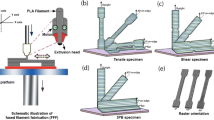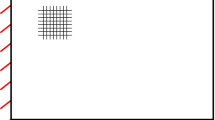Abstract
The distinct process of layer-by-layer 3D printing generates an anisotropic distribution of mechanical properties. The use of computational models to predict the mechanical properties of 3D-printed objects made by fused filament fabrication (FFF) has received little attention despite a large literature on experimental approaches. The primary objective of this study is to investigate the application of multi-scale computational models in order to achieve precise predictions of the mechanical properties of observed components. A numerical homogenization method is used in combination with clustering algorithms, notably the “K-means” algorithm, to adjust the predicted behavior of the parts to the actual properties resulting from this process as a function of the variation of the raster angle. This method analyzes samples’ internal structure at the micro- and mesoscales. K-means algorithms classify observations to create representative volume elements (RVEs) that match the reel morphologies of the interlayer cavities. The data is utilized to create micromechanical models that calculate effective orthotropic constants based on filament orientation; the derived constants are then used to develop macroscale numerical models that simulate the mechanical response of 3D-printed samples subjected to tensile stress. In summary, the findings suggest that employing the homogenization technique is a reliable approach for forecasting the elastic behavior of 3D-printed elements. Moreover, it is imperative to utilize existing models, such as homogenization utilizing Green’s functions or homogenization based on ideal geometry-material models, in order to obtain an initial approximation of the elastic response of 3D-printed components. Furthermore, the methodology employed in this study, which combines the homogenization process with intelligent clustering algorithms, effectively minimizes the error between numerical simulations and experimental findings. This, in turn, improves the development of precise predictive models that accurately represent the elastic properties of structures fabricated using FFF. This methodology has the potential to be implemented across all materials utilized in FFF manufacturing. This study presents trustworthy prediction laws that enable the designer to conduct a quicker iterative analysis and select the ideal printing process parameters based on FE analysis in order to create high-quality 3D FFF-printed components.

























Similar content being viewed by others
Data availability
The sets of data developed and/or examined through the present research are available upon reasonable request from the corresponding author.
References
ISO/ASTM52900-15 (2015) Standard terminology for additive manufacturing–general principles–terminology. International Organization for Standardization, Geneva, Switzerland
Motaparti KP (2016) Effect of build parameters on mechanical properties of ultem 9085 parts by fused deposition modeling. Missouri University of Science and Technology
Matlack M, Castle J, Taylor G, Wang X, Mason L, Leu M-C, Chandrashekhara K (2016) Investigation of ULTEM 1010 FDM sparse-build parts using design of experiments and numerical simulation. Proc Compos Adv Mater Expo 2016:1–11
Cao D, Malakooti S, Kulkarni VN, Ren Y, Lu H (2021) Nanoindentation measurement of core–skin interphase viscoelastic properties in a sandwich glass composite. Mech Time Depend Mater 25:353–363. https://doi.org/10.1007/S11043-020-09448-Y/METRICS
Wang X, Xu T, de Andrade MJ, Rampalli I, Cao D, Haque M, Roy S, Baughman RH, Lu H (2021) The interfacial shear strength of carbon nanotube sheet modified carbon fiber composites. Springer, pp 25–32. https://doi.org/10.1007/978-3-030-59542-5_4
Cao D, Malakooti S, Kulkarni VN, Ren Y, Liu Y, Nie X, Qian D, Griffith DT, Lu H (2022) The effect of resin uptake on the flexural properties of compression molded sandwich composites. Wind Energy 25:71–93. https://doi.org/10.1002/WE.2661
Sood AK, Ohdar RK, Mahapatra SS (2009) Improving dimensional accuracy of fused deposition modelling processed part using grey Taguchi method. Mater Des 30:4243–4252
Lee P-H, Chung H, Lee SW, Yoo J, Ko J (2014) Dimensional accuracy in additive manufacturing processes. In: International manufacturing science and engineering conference. Am Soc Mech Eng:V001T04A045
Ahn D, Kweon J-H, Kwon S, Song J, Lee S (2009) Representation of surface roughness in fused deposition modeling. J Mater Process Technol 209:5593–5600
Boschetto A, Giordano V, Veniali F (2012) Modelling micro geometrical profiles in fused deposition process. Int J Adv Manuf Technol 61:945–956
Telea A, Jalba A (2011) Voxel-based assessment of printability of 3D shapes. In: International symposium on mathematical morphology and its applications to signal and image processing. Springer, pp 393–404
Nelaturi S, Shapiro V (2015) Representation and analysis of additively manufactured parts. Computer-Aided Design 67:13–23
Gonabadi H, Chen Y, Yadav A, Bull S (2022) Investigation of the effect of raster angle, build orientation, and infill density on the elastic response of 3D printed parts using finite element microstructural modeling and homogenization techniques. Int J Adv Manuf Technol 118:1485–1510. https://doi.org/10.1007/s00170-021-07940-4
Letcher T, Waytashek M (2014) Material property testing of 3D-printed specimen in PLA on an entry-level 3D printer. In: ASME international mechanical engineering congress and exposition. American Society of Mechanical Engineers, p V02AT02A014
International A (2013) Standard test method for short-beam strength of polymer matrix composite materials and their laminates. ASTM International
Yu L, Cao Y, Yang JYH, Yang P (2022) Benchmarking clustering algorithms on estimating the number of cell types from single-cell RNA-sequencing data. Genome Biol 23:1–21
Likas A, Vlassis N, Verbeek JJ (2003) The global k-means clustering algorithm. Pattern Recognit 36:451–461
Cerda-Avila SN, Medellín-Castillo HI, De Lange DF (2019) Analysis and numerical simulation of the structural performance of fused deposition modeling samples with variable infill values. J Eng Mater Technol Trans ASME 141. https://doi.org/10.1115/1.4041854/366891
Liu X, Shapiro V (2016) Homogenization of material properties in additively manufactured structures. Computer-Aided Design 78:71–82
Monaldo E, Sciences SM-IJ of M (2021) Computational homogenization of 3D printed materials by a reduced order model. Elsevier
Yao T, Zhang K, Deng Z, Design JY-M (2020) A novel generalized stress invariant-based strength model for inter-layer failure of FFF 3D printing PLA material. Elsevier
Somireddy M, Design AC-M (2020) Anisotropic material behavior of 3D printed composite structures–material extrusion additive manufacturing. Elsevier
Tang C, Liu J, Yang Y, Liu Y, Jiang S, Open WH-CPC (2020) Effect of process parameters on mechanical properties of 3D printed PLA lattice structures. Elsevier
Lubombo C, Communications MH-MT (2018) undefined. Effect of infill patterns on the mechanical performance of lightweight 3D-printed cellular PLA parts. Elsevier
Aldin A, Qattawi A (2018) Investigating the effect of fused deposition modeling processing parameters using Taguchi design of experiment method. J Manuf Process 36:164–174. https://doi.org/10.1016/j.jmapro.2018.09.025
International A (2007) Standard test method for flexural properties of polymer matrix composite materials. ASTM International
ASTM A (2008) D638-08 standard test method for tensile properties of plastics. Plastics (I):D256–D3159
International A (2012) ASTM D5379/D5379M-12-standard test method for shear properties of composite materials by the V-notched beam method. ASTM International West Conshohocken
Torres J, Cotelo J, Karl J, Gordon AP (2015) Mechanical property optimization of FDM PLA in shear with multiple objectives. Jom 67:1183–1193
Dhankhar P (2014) Homogenization fundamentals. IOSR J Eng 4:1–8
Bellehumeur C, Li L, Sun Q, Gu P (2004) Modeling of bond formation between polymer filaments in the fused deposition modeling process. J Manuf Process 6:170–178
Mutlag W, Ali S et al (2020) Feature extraction methods: a review. https://doi.org/10.1088/1742-6596/1591/1/012028
Nainggolan R, … RP-J of P, 2019. Improved the performance of the K-means cluster using the sum of squared error (SSE) optimized by using the elbow method. iopscience.iop.org
Shutaywi M, Kachouie NN, Scarfone M (2021) Silhouette analysis for performance evaluation in machine learning with applications to clustering. mdpi.com. https://doi.org/10.3390/e23060759
Sun Q, Rizvi GM, Bellehumeur CT, Gu P (2008) Effect of processing conditions on the bonding quality of FDM polymer filaments. Rapid Prototyp J 14(2):72–80
Acknowledgements
We thank our colleagues from the Mechanical Engineering Laboratory, Faculty of Science and Technology (FST)—FEZ, Sidi Mohamed Ben Abdellah University, who provided insight and expertise that greatly assisted the research.
Author information
Authors and Affiliations
Corresponding author
Ethics declarations
Ethics approval
The specified work has never been published.
Consent for publication
All authors allowed the publication of the final manuscript.
Conflict of interest
The authors declare no competing interests.
Additional information
Publisher’s note
Springer Nature remains neutral with regard to jurisdictional claims in published maps and institutional affiliations.
Rights and permissions
Springer Nature or its licensor (e.g. a society or other partner) holds exclusive rights to this article under a publishing agreement with the author(s) or other rightsholder(s); author self-archiving of the accepted manuscript version of this article is solely governed by the terms of such publishing agreement and applicable law.
About this article
Cite this article
Ait Benaissa, H., Zaghar, H., Moujibi, N. et al. Prediction and examination of the impact of the raster angle on the orthotropic elastic response of 3D-printed objects using a novel homogenization strategy based on the real clustering of RVEs. Int J Adv Manuf Technol 129, 399–420 (2023). https://doi.org/10.1007/s00170-023-12101-w
Received:
Accepted:
Published:
Issue Date:
DOI: https://doi.org/10.1007/s00170-023-12101-w




